Left turn traffic signals are used to relieve traffic backups in left turn lanes. They provide left turns protected from
conflict from oncoming traffic.
A phase is a set of signals controlling a particular traffic movement.
Each left turn phasing is explained in detail here.
The various kinds of phasing are determined by the order in which the traffic phases are displayed.
The map symbols shown are used to indicate phasing patterns on maps showing traffic signal locations. These symbols are defined
here.
| SIMPLE INTERSECTIONS WITHOUT LEFT TURN PHASES |
|---|
PHASE
ANIMATION | CYCLE
SYMBOL
& NAME | LEFT
SIGNAL
TYPE |
NORMAL PHASE SEQUENCE ---- TIME ----> |
DISCUSSION |
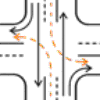 |
 No left
signals |
Permissive |
 |
 |
|
|
|
|
Each street gets one signal phase. Left turns are made through gaps in opposing traffic.
See note A. |
|
 Tee,
no left
signals |
Permissive |
 |
 |
|
|
|
|
Each street gets one signal phase. Left turns are made through gaps in opposing traffic.
See note A. |
|
 One-way
no left
signals |
Permissive |
 |
 |
|
|
|
|
Each street gets one signal phase. Left turns are made through gaps in opposing traffic.
See note A. |
|
The following information pertains to left turn phasing and the diagrams:
- A phase is one traffic movement or set of movements that all occur together.
- Permissive (also called exclusively permissive) left turns are made through gaps in opposing traffic.
- Protected (also called exclusively protected) left turns are made when opposing traffic is stopped.
- P/P is Protected/Permissive. During one phase, the left turn is protected, and during another phase, they are
permissive.
- A black curved arrow on a diagram indicates a protected turn.
- An orange dashed curved arrow indicates a permissive turn provided by a flashing yellow arrow (or a circular
green, if yellow trap is allowed).
- For exclusively protected left turn phasing, ignore the orange arrows in the diagrams.
|
|
| TEE INTERSECTIONS AND ONE-WAY STREETS |
|---|
PHASE
ANIMATION | CYCLE
SYMBOL
& NAME | LEFT
SIGNAL
TYPE |
NORMAL PHASE SEQUENCE ---- TIME ----> |
DISCUSSION |
|
 Tee
lead |
Protected
or P/P |
 |
 |
 |
|
|
|
The leading left turn is before the opposing thru phase.
See note A. |
|
 Tee
lag |
Protected
or P/P |
 |
 |
 |
|
|
|
The lagging left turn is after the opposing thru phase.
See note A. |
|
 One-way
lead |
Protected
or P/P |
 |
 |
 |
|
|
|
The leading left turn is before the opposing thru phase.
See note A. |
|
 One-way
lag |
Protected
or P/P |
 |
 |
 |
|
|
|
The lagging left turn is after the opposing thru phase.
See note A. |
|
| In the following sequences, note how a left turn can go with its adjacent thru
movement. When two movements go at the same time, it is said that they overlap: |
|
| SINGLE LEFT TURN, ONE LEFT TURN INTERVAL |
|---|
PHASE
ANIMATION | CYCLE
SYMBOL
& NAME | LEFT
SIGNAL
TYPE |
NORMAL PHASE SEQUENCE ---- TIME ----> |
DISCUSSION |
|
 Single
lead |
Protected
or P/P |
 |
 |
 |
|
|
|
The leading left turn is before the opposing thru phase.
See notes B and F. |
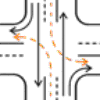 |
 Single
lag |
Protected
or P/P |
 |
 |
 |
|
|
|
The lagging left turn is after the opposing thru phase.
See note C and F. |
|
| Left turns from opposite directions can also overlap (go simultaneously). The thru
movements also overlap: |
|
| DUAL LEFT, ONE LEFT TURN INTERVAL |
|---|
PHASE
ANIMATION | CYCLE
SYMBOL
& NAME | LEFT
SIGNAL
TYPE |
NORMAL PHASE SEQUENCE ---- TIME ----> |
DISCUSSION |
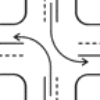 |
 Dual
lead |
Protected
or P/P |
 |
 |
 |
|
|
|
The leading left turns are before the opposing thru phase. The left turns end simultaneously.
See notes A and F. |
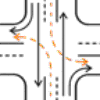 |
 Dual
lag |
Protected
or P/P |
 |
 |
 |
|
|
|
The lagging left turns are after the opposing thru phase. The thru movements end simultaneously.
See notes A and F. |
|
| The above methods can be combined to produce more efficient sequences. One overlap
changes to another overlap when traffic demand ends: |
|
| SPLIT LEFT TURNS ON ONE STREET |
|---|
PHASE
ANIMATION | CYCLE
SYMBOL
& NAME | LEFT
SIGNAL
TYPE |
NORMAL PHASE SEQUENCE ---- TIME ----> |
DISCUSSION |
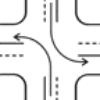 |
 Dual
split
lead |
Protected
or P/P |
 |


|
 |
 |
|
|
The leading left turns are before the opposing thru phases. Note that each left turn phase can end
separately. Each one ends as soon as it runs out of traffic.
See notes D and F. |
 |
 Dual
split
lag |
Protected
or P/P |
 |


|
 |
 |
|
|
The lagging left turns are after the opposing thru phases. Note that each thru phase can end separately.
Each one ends as soon as it runs out of traffic.
See notes C and F. |
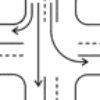 |
 Dual
lead-lag
no split |
Protected |
 |
 |
 |
|
|
|
Each leg of the street with left turn phases has its own phase. Each phase ends as soon as it runs out of
traffic. This is also called Split Phasing.
See note E. |
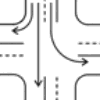 |
 Dual
lead-lag
1 split |
Protected
or P/P |
 |
 |
 |
 |
|
|
The leading left turn is before the opposing thru phase. The lagging left turn is after the opposing thru
phase. Note that the leading left turn phase must end before the lagging left turn phase can begin.
See note C. |
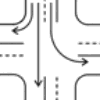 |
 Dual
lead-lag
2 split |
protected
or P/P |
 |


|
 |
 |
|
|
The leading left turn is before the opposing thru phase. The lagging left turn is after the opposing thru
phase. Either the leading left turn or its parallel thru phase can end first. Each one ends as soon as it runs out of traffic.
See notes C and F. |
|
| A set of left turn phases can also be added to each street: |
|
| ONE LEFT TURN INTERVAL ON EACH STREET |
|---|
PHASE
ANIMATION | CYCLE
SYMBOL
& NAME | LEFT
SIGNAL
TYPE |
NORMAL PHASE SEQUENCE ---- TIME ----> |
DISCUSSION |
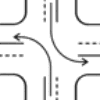 |
 Quad
lead |
Protected
or P/P |
 |
 |
 |
 |
|
|
The leading left turns are before the opposing thru phase. The left turns end together.
See notes A and F. |
|
 Quad
lag |
Protected
or P/P |
 |
 |
 |
 |
|
|
The lagging left turns are after the opposing thru phase. The thru movements end together.
See notes A and F. |
|
| SPLIT LEFT TURNS ON BOTH STREETS |
|---|
PHASE
ANIMATION | CYCLE
SYMBOL
& NAME | LEFT
SIGNAL
TYPE |
NORMAL PHASE SEQUENCE ---- TIME ----> |
DISCUSSION |
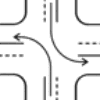 |
 Quad
split
lead |
Protected
or P/P |
 |


|
 |
 |


|
 |
The leading left turns are before the opposing thru phases. Note that each left turn phase can end
separately. Each one ends as soon as it runs out of traffic.
See notes D and F. |
|
 Quad
split
lag |
Protected
or P/P |
 |


|
 |
 |


|
 |
The lagging left turns are after the opposing thru phases. Note that each thru phase can end separately.
Each one ends as soon as it runs out of traffic.
See note C and F. |
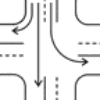 |
 Quad
lead-lag
no split |
Protected |
 |
 |
 |
 |
|
|
Each leg of each street has its own phase. Each phase ends as soon as it runs out of
traffic. This is also called Split Phasing.
See note E. |
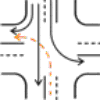 |
 Quad
lead-lag
1 split |
Protected
or P/P |
 |
 |
 |
 |
 |
 |
The leading left turn is before the opposing thru phase. The lagging left turn is after the opposing
thru phase. Note that the leading left turn phase must end before the lagging left turn phase can begin.
See note C. |
|
 Quad
lead-lag
2 split |
Protected
or P/P |
 |


|
 |
 |


|
 |
The leading left turn is before the opposing thru phase. The lagging left turn is after the opposing
thru phase. Either the leading left turn or its parallel thru phase can end first. Each one ends as soon as it runs
out of traffic.
See notes C and F. |
|
| COMBINED SEQUENCES |
|---|
PHASE
ANIMATION | CYCLE
SYMBOL
& NAME | LEFT
SIGNAL
TYPE |
NORMAL PHASE SEQUENCE ---- TIME ----> |
DISCUSSION |
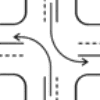 |

Quad
split
lead, &
lead-lag
no split |
Protected
or P/P |
 |


|
 |
 |
 |
|
This is a combination of the dual split lead and the dual lead lag, no split. Each street has the
characteristics of the dual left turn sequence used.
See note D and F. |
|
 Double
single
lead |
Protected
or P/P |
 |
 |
 |
 |
|
|
This is a combination of two single lead left turns. The leading left turns are before the opposing
thru phase.
See notes B and F. |
|

Dual
split
lead &
single
lead |
Protected
or P/P |
 |


|
 |
 |
 |
|
This is a combination of a dual split lead and a single lead. The leading left turns are before the
opposing thru phase.
See notes B and F. |
|
| ROTATING SEQUENCES |
|---|
PHASE
ANIMATION | CYCLE
SYMBOL
& NAME | LEFT
SIGNAL
TYPE |
NORMAL PHASE SEQUENCE ---- TIME ----> |
DISCUSSION |
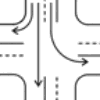 |

Quad
clock-
wise
no split |
Protected |
 |
 |
 |
 |
|
|
Each leg of each street has its own phase. But the two phases for the same street are not next to each
other in time. This is a form of Split Phasing used for progression purposes.
See note E. |
|

Quad
counter-
clock-
wise
no split |
Protected |
 |
 |
 |
 |
|
|
Each leg of each street has its own phase. But the two phases for the same street are not next to each
other in time. This is a form of Split Phasing used for progression purposes.
See note E. |
|
| NEW SEQUENCES WITH FLASHING YELLOW ARROWS (FYA) |
|---|
PHASE
ANIMATION | CYCLE
SYMBOL
& NAME | LEFT
SIGNAL
TYPE |
NORMAL PHASE SEQUENCE ---- TIME ----> |
DISCUSSION |
|

Quad
lead-lag
no split
With FYA |
P/P |
 |
 |
 |
 |
|
|
Each leg of each street has its own phase, but with permissive opposing left turns. This is a special
version of Split Phasing.
See note F. |
|

Quad
clock-
wise
no split
With FYA |
P/P |
 |
 |
 |
 |
|
|
Each leg of each street has its own phase, but with permissive opposing left turns. This is a form of
Split Phasing used for progression purposes.
See note F. |
|
| HALF SIGNALS AND PEDESTRIAN CROSSINGS |
|---|
PHASE
ANIMATION | CYCLE
SYMBOL
& NAME | LEFT
SIGNAL
TYPE |
NORMAL PHASE SEQUENCE ---- TIME ----> |
DISCUSSION |
|

Half
signal |
Protected
or P/P |
 |
 |
|
|
|
|
The half signal does not stop traffic in one direction. If the west road is two-way, traffic entering
from it is restricted to right turns, and moves when the overlapping left turn moves. This signal can always fit into
any progression plan. |
|

Dual
half
signal |
Protected
or P/P |


|


|
|
|
|
|
There are two completely independent signals at this intersection. Traffic entering from the
east-west road is restricted to right turns, and moves when the overlapping left turn moves. This signal system can
always fit into any progression plan.
See notes A and C. |
|

Pedestrian
signal |
Protected |
 |
 |
|
|
|
|
This signal is not at an intersection with another road, but with a pedestrian path. Ignore the
right turns in the diagram.
See notes A and C. |
|
| ODD SEQUENCES FOR PROGRESSION |
|---|
PHASE
ANIMATION | CYCLE
SYMBOL
& NAME | LEFT
SIGNAL
TYPE |
NORMAL PHASE SEQUENCE ---- TIME ----> |
DISCUSSION |
|
*
Quad
separated
turns | Protected |
 |
 |
 |
 |
|
|
The left turns are separated from the opposing thru phase. The two phases for the same street are
not next to each other in time. The left turns end together.
See note F. |
|
*
Dual
double
sequence | Protected |
 |
 |
 |
 |
|
|
The thru phase appears twice in each cycle to accommodate progression or mass transit.
See notes A and F. |
|
*
Split
double
sequence | Protected |
 |
 |
 |
 |
|
|
The thru phase appears twice in each cycle to accommodate progression or mass transit.
See notes A and F. |
|
*
Dual &
Split
triple
sequence | Protected |
 |
 |
 |
 |
 |
 |
The thru phase appears 3 times in each cycle to accommodate progression or mass transit.
See notes A and F. |
|
* These sequences would be given as a map symbol a circle with a number in it. This would refer to a diagram on one
side of the map.
| TIMING RINGS |
|---|
| Traffic signals use what are called timing rings. Each ring contains the timing
circuits that time the various intervals needed for several different phases at different times. The phases timed
by one ring are phases that can never occur together. Here is how two timing rings can produce phase sequences we
see in the above diagrams. |
| EXCLUSIVELY PROTECTED TIMING RING SETUP |
|---|
| TIMING GROUPS |
Group 1 |
Group 2 |
| |
Group 3 |
Group 4 |
| |
| RING 1 |
 Phase 1 |
 Phase 2 |
| |
 Phase 3 |
 Phase 4 |
| |
| RING 2 |
 Phase 5 |
 Phase 6 |
| |
 Phase 7 |
 Phase 8 |
| |
| CONCURRENCY |
Group 1 |
| |
Group 2 |
| |
| ------ PHASE ORDER ------> |
|---|
|
- Each phase must be a member of one ring, one timing group, and one concurrency group.
- Each ring normally advances from one timing group to the next, in the direction of the phase order arrow. The
sequence then repeats.
- The | marks are the barriers. Both rings must be on the same side of each barrier at the same time. They must
cross the barrier simultaneously.
- The barriers separate the concurrency groups. Phases 1, 2, 5, and 6 are in one concurrency group, and
phases 3, 4, 7, and 8 are in the other group.
- If no traffic is waiting to use a phase, the timing ring can skip it. The ring either will not display any
green indication, or it will advance to a later phase. But it must wait to cross the barrier until the other ring has
finished its own timing.
- If no phases in the other concurrency group have waiting traffic, a ring can move backwards within the same
concurrency group.
|
| Timing groups in use |
Both rings
in timing
group 1 |
One ring
in group 1,
one ring in
group 2 |
Both rings
in timing
group 2 |
Both rings
in timing
group 3 |
One ring in
in group 3,
one ring in
group 4 |
Both rings
in timing
group 4 |
|
 |
 Quad
split
lead |
Protected
or P/P |
Phases  1 & 5 |
1 & 6 
Phases

2 & 5 |
Phases  2 & 6 |
Phases  3 & 7 |
4 & 7 
Phases

3 & 8 |
Phases  4 & 8 |
- The leading left turns occur before the opposing thru phases.
- Each left turn phase can end separately, as its vehicle queue empties, and its timing ring advances to the
next phase.
- The straight-ahead phases must usually end together, because the rings must cross the barrier together.
|
| To get the other sequences, the various phases are moved to different timing
groups or omitted. |
|
| CIRCULAR GREEN PROTECTED/PERMISSIVE TIMING RINGS |
|---|
| CIRCULAR GREEN PROTECTED/PERMISSIVE TIMING |
|---|
| TIMING GROUPS |
Group 1 |
Group 2 |
| |
Group 3 |
Group 4 |
| |
| RING 1 |
 Phase 1 |
 Phase 2 |
| |
 Phase 3 |
 Phase 4 |
| |
| RING 2 |
 Phase 5 |
 Phase 6 |
| |
 Phase 7 |
 Phase 8 |
| |
| CONCURRENCY |
Group 1 |
| |
Group 2 |
| |
| ------ PHASE ORDER ------> |
|---|
|
- Each phase must be a member of one ring, one timing group, and one concurrency group.
- Each permissive left turn (orange) and its protected turn are in different rings.
- Each ring normally advances in the direction of the phase order arrow.
- Both rings must be on the same side of each barrier | at the same time.
- The barriers separate the concurrency groups. Phases 1, 2, 5, and 6 are in one concurrency group, and
phases 3, 4, 7, and 8 are in the other group.
- If no traffic is waiting to use a phase, the timing ring can skip it. But both rings must cross the barrier
together.
- If no phases in the other concurrency group have waiting traffic, a ring can move backwards within the same
concurrency group. This causes yellow trap.
- Yellow Trap Example: While phase 6 is active, a change from phase 2 to phase 1 causes yellow trap for the
phase 5 movement.
|
|
| FLASHING YELLOW ARROW PROTECTED/PERMISSIVE TIMING RINGS |
|---|
| FLASHING YELLOW ARROWS P/P TIMING |
|---|
| TIMING GROUPS |
Group 1 |
Group 2 |
| |
Group 3 |
Group 4 |
| |
| RING 1 |
 Phase 1 |
 Phase 2 |
| |
 Phase 3 |
 Phase 4 |
| |
| RING 2 |
 Phase 5 |
 Phase 6 |
| |
 Phase 7 |
 Phase 8 |
| |
| CONCURRENCY |
Group 1 |
| |
Group 2 |
| |
| ------ PHASE ORDER ------> |
|---|
|
- Each phase must be a member of one ring, one timing group, and one concurrency group.
- Each permissive left turn (orange) and its protected turn are in the same ring.
- Each ring normally advances in the direction of the phase order arrow.
- Both rings must be on the same side of each barrier | at the same time.
- The barriers separate the concurrency groups. Phases 1, 2, 5, and 6 are in one concurrency group, and
phases 3, 4, 7, and 8 are in the other group.
- If no traffic is waiting to use a phase, the timing ring can skip it. But both rings must cross the barrier
together.
- If no phases in the other concurrency group have waiting traffic, a ring can move backwards within the same
concurrency group.
- Yellow Trap Prevention: While phase 6 is active, a change from phase 2 to phase 1 prevents yellow trap for the
phase 5 movement.
|
| SIGNAL GLOSSARY |
| TERM | DEFINITION |
| YELLOW TRAP |
Trapping left turning drivers in the intersection with a red light, while opposing traffic still has
a green. |
| LAG TRAP |
Yellow-Trap. |
| LAG LEFT TURN TRAP |
Yellow-Trap |
| SECOND YELLOW TRAP |
Trapping left turning drivers in the intersection with a red light, while opposing right-turns
have green arrows. |
| TEE |
Tee intersection. A driveway must not exist where the fourth leg would be. |
| LEAD |
Left turn goes immediately before oncoming straight ahead. |
| LAG |
Left turn goes immediately after oncoming straight ahead. |
| LEAD-LAG |
From one direction, the left turn leads. From the other direction, the left turn lags. |
| EXCLUSIVELY PERMITTED |
Left turns must be made through gaps in opposing traffic. |
| EXCLUSIVELY PROTECTED |
All left turns must be made when a green arrow is displayed. |
| PROTECTED/PERMITTED |
Left turns are made either with a green arrow or through gaps in opposing traffic. |
| P/P |
Protected/Permitted. |
| SEPARATED |
Other phases separate the two phases for the street on both sides. |
| SIMULTANEOUS |
Both left turn signals act at the same time (opposite of split). |
| SPLIT |
The left turn phases can begin or end at different times. |
| SPLIT-PHASE |
Each leg of the road has a separate adjacent phase. This is the same as an unsplit lead-lag. |
| ENGLISH |
Left turns are braided a distance away from the intersection, to drive on the left side. |
| MERGE |
Extra merging overlap combinations are possible due to channelization. |
| FLASHING YELLOW ARROW |
A signal indication for permissive turn that is independent of the thru movement signal indication. |
| FLASHING YELLOW ARROW INDICATION |
Prevents Yellow-Trap by extending the opposing permissive left turn through the lag turn phase. |
| FYA |
Flashing Yellow Arrows. |

































































































































































































































